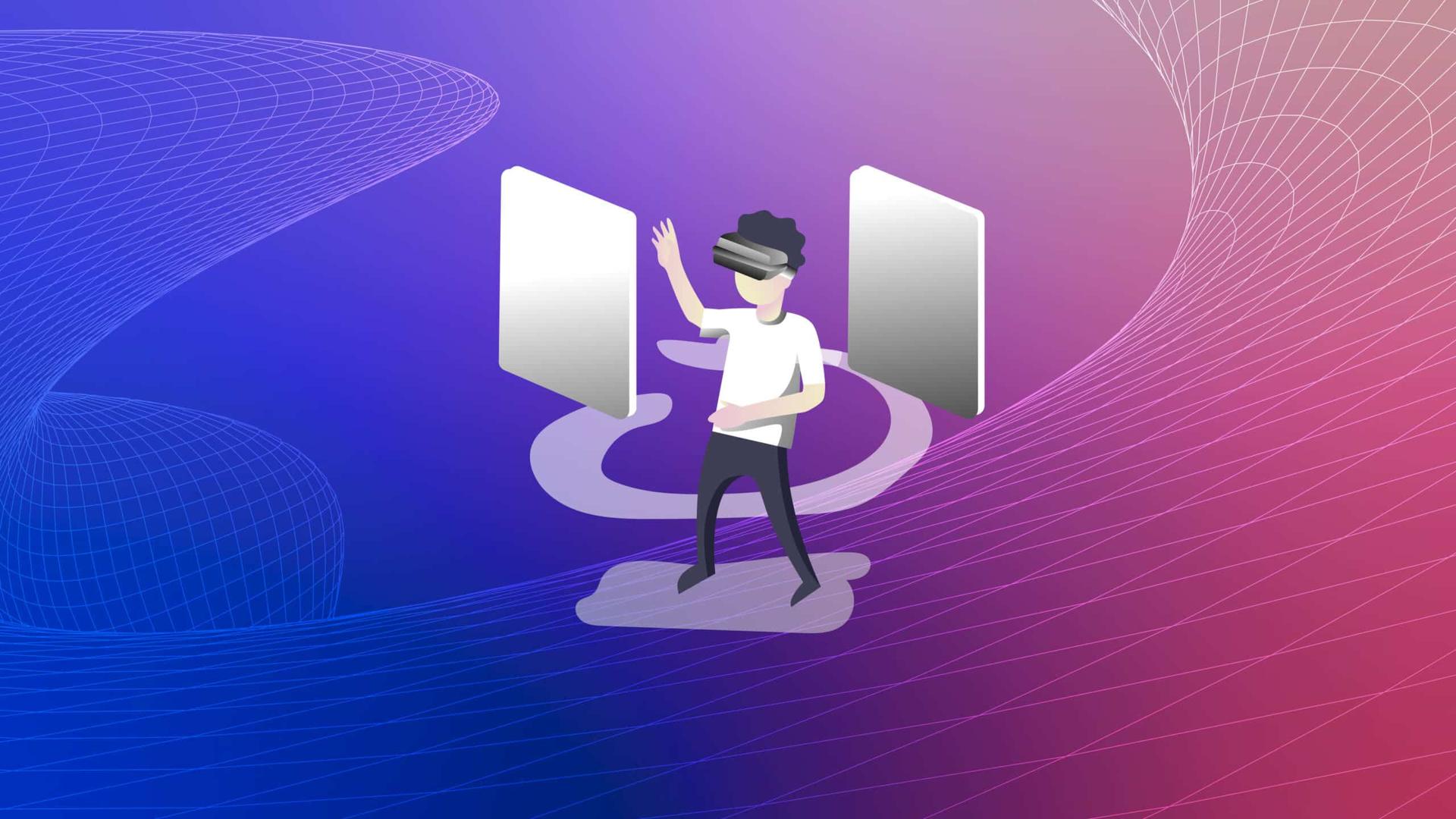The Metaverse Technologies: VR, AR, And Beyond

The metaverse concept has captured the imagination of tech enthusiasts, futurists, and entrepreneurs alike. It promises a digital realm where people can interact, work, and play, blurring the lines between the physical and virtual worlds. A diverse range of metaverse technologies are being developed to achieve this vision.
Join Metastack as we explore metaverse technologies, discussing what they are, how they work, and their potential impact on society.
What Exactly is the Metaverse?
The metaverse represents a virtual universe, an interconnected digital realm where users can interact, socialize, and create within shared, immersive environments.
It transcends individual platforms and applications, offering a unified, persistent, and ever-evolving digital space that mirrors physical world elements while introducing new possibilities.
Metaverse technologies drive this transformative concept, challenging our conventional notions of space, time, and social interaction. They provide the means to construct and navigate this digital universe, creating a seamless blend of reality and imagination.
Read: What Is Metaverse And How It Will Change Our Lives

Evolution of Metaverse Technologies
The evolution of metaverse technologies is a fascinating journey that spans several decades, marked by technological advancements, cultural shifts, and visionary ideas.
Conceptual Origins (Early 20th Century to 1980s): The metaverse concept traces back to early science fiction, notably Neal Stephenson's "Snow Crash" in the 1980s, which popularized the term.
Virtual Reality Emergence (1980s to 1990s): The 1980s witnessed the emergence of Virtual Reality (VR) as a foundational technology for the metaverse, with early VR headsets and concepts.
Internet and Cyberspace (1990s): The growth of the internet in the 1990s contributed to the idea of "cyberspace" and early shared online spaces.
Virtual Worlds and Mass Adoption (2000s to 2010s): Virtual worlds like Second Life and MMOs laid the groundwork for shared digital environments, introducing millions to virtual interactions.
Metaverse Building Blocks (2010s to Present): The 2010s brought advancements in VR, AR, blockchain, NFTs, social VR, mixed reality (MR), AI, and realistic virtual environments.
Read: A Brief History of Virtual Worlds Leading to the Metaverse
Metaverse Technologies: Introducing the Main Characters
Now, let's discuss the key technologies that are fueling the metaverse, making the experiences in it more realistic and immersive:
Virtual Reality (VR)
Virtual Reality (VR) is one of the most recognized and widely adopted metaverse technologies. This technology immerses users in digitally rendered environments by employing VR headsets, often paired with hand controllers or input devices, completely replacing their physical surroundings.
Critical attributes of VR technology encompass:
Immersive Environments: VR delivers a profound sense of presence by enveloping users within computer-generated worlds, allowing interactions with virtual elements.
Hardware and Software: The deployment of VR necessitates specialized hardware, such as headsets and motion controllers, along with software applications to facilitate immersive experiences.
Applications: Beyond gaming, VR finds application in diverse fields like education, and healthcare, showcasing its potential across industries.
Augmented Reality (AR)
Augmented Reality (AR) represents another metaverse technology component that enhances real-world experiences by overlaying digital information onto physical surroundings rather than replacing them, as VR does.
Key attributes of AR technology encompass:
Real-world Integration: AR seamlessly integrates digital elements – information, graphics, and animations – into the user's view of the physical world, often through devices like smartphones, smart glasses, or headsets.
Contextual Awareness: AR applications leverage sensors and computer vision to interpret the user's environment, providing relevant information based on real-world context.
Use Cases: AR finds application in diverse scenarios, including navigation, gaming (e.g., Pokémon Go), remote assistance, and industrial training, highlighting its versatility.
Read: How Virtual Reality (VR) and Augmented Reality (AR) Fuels the Metaverse Growth
Mixed Reality (MR)
Mixed Reality (MR) is one of the metaverse technologies that bridges the gap between virtual and physical environments by combining elements of both VR and AR. MR allows digital objects to interact with the natural world and vice versa, creating a seamless blend of virtual and physical experiences.
Key characteristics of MR technology include:
Spatial Understanding: MR systems deeply understand the user's physical environment, enabling digital objects to interact with real-world surfaces and objects.
Holographic Displays: MR headsets often feature transparent visors or lenses that allow users to simultaneously see virtual and real-world content.
Interactive Virtual Objects: Users can manipulate and interact with virtual objects in the real world, such as placing a digital sculpture on their physical desk.
Applications: MR technology is used in fields like architecture, engineering, and design for visualization and collaboration, as well as in gaming and entertainment.
Haptic feedback
Haptic feedback technology is essential to metaverse technologies, providing users with tactile sensations and physical feedback. This technology enhances immersion by allowing users to feel and interact with virtual objects as if they were real.
Key features of haptic feedback technology include:
Tactile Feedback: Haptic devices simulate physical sensations, such as touch, pressure, and texture, to make virtual experiences more realistic.
Force Feedback: Some haptic devices can apply force or resistance to simulate interactions with objects in the virtual world.
Applications: Haptic feedback is crucial in VR, AR, and MR applications, especially in fields like gaming, training, and simulations, where realistic touch and feel are essential.
Artificial Intelligence (AI)
Artificial Intelligence (AI) is a pivotal component of metaverse technologies, playing a transformative role in shaping the metaverse's capabilities and experiences. AI brings intelligence, adaptability, and personalization to virtual environments, enhancing their functionality and interactivity.
Key features:
Dynamic NPCs: AI-driven characters enhance interactivity and realism.
Natural Language Processing: Enables conversational interactions and virtual assistants.
Personalization: AI tailors content and recommendations to user preferences.
Content Generation: Accelerates world-building and generates dynamic environments.
Adaptive Interfaces: AI streamlines user experiences with predictive interfaces.
Immersive Storytelling: AI-driven narratives respond to user choices.
The Metaverse of Things
As we explore metaverse technologies, we must delve into the emerging concept of the "Metaverse of Things" (MoT). This notion refers to integrating Internet of Things (IoT) devices into the metaverse, creating a network of interconnected objects and sensors within virtual spaces.
IoT in the Metaverse
The Internet of Things (IoT) consists of everyday objects endowed with sensors, software, and connectivity to collect and exchange data. In the metaverse context, IoT devices, just like metaverse technologies, enhance the overall experience:
Smart Environments: IoT devices craft interconnected, innovative environments within the metaverse, for instance, adjusting lighting and temperature in a virtual office based on user preferences.
Enhanced Interactivity: Integration of IoT devices facilitates more natural interactions with virtual objects and environments, such as using hand gestures through an AR headset to control virtual appliances within a virtual kitchen.
Data Collection and Analytics: IoT devices in the metaverse can amass data on user behavior, preferences, and interactions, serving as valuable sources for enhancing user experiences and informing decisions within the virtual realm.
Read: The Latest VR & AR Gadgets Elevating the Metaverse Experience

Challenges and Considerations
While the metaverse technologies offer great promise, it also ushers in various challenges and considerations:
Privacy and security concerns
Metaverse technologies collect vast amounts of user data, including their behaviors, preferences, and interactions within virtual environments. Ensuring the privacy and security of this data is crucial.
Ethical and social implications
The metaverse blurs the lines between the real and virtual worlds, raising ethical questions about how people interact within these environments. Issues related to harassment, cyberbullying, addiction, and the creation of digital personas with harmful intent need to be addressed.
Digital divide
Only some have equal access to metaverse technologies due to cost, internet infrastructure, and technological literacy. This digital divide can exacerbate existing social and economic inequalities. Ensuring the metaverse is accessible and inclusive for all is a critical challenge.
Content moderation and governance
Content moderation and governance become challenging as user-generated content becomes a significant part of the metaverse. Ensuring that virtual spaces are safe and free from harmful content while respecting freedom of expression is a complex balancing act.
The Future of Metaverse Technologies
As metaverse technologies continue to evolve, several emerging trends and possibilities come to the forefront:
Social interaction and collaboration
The metaverse technologies hold immense potential for revolutionizing social interaction. Users can connect with friends, family, and colleagues in virtual spaces, attend meetings and events, or simply engage in digital gatherings.
Education and training
Education and training stand to benefit significantly from metaverse technologies. Students can immerse themselves in historical events, explore distant planets, or engage in medical simulations in a risk-free virtual environment.
Read: Forget About Campus: Higher Education In The Metaverse
Entertainment and gaming
The entertainment industry is at the forefront of capitalizing on metaverse technologies, with VR gaming gaining prominence. Future gaming experiences promise greater interactivity and immersion, combining digital and physical worlds.
Healthcare and therapy
Metaverse technologies have the potential to revolutionize healthcare, aiding in medical training, surgical simulations, and various therapeutic applications. Patients can access virtual support groups and therapeutic environments for mental health support.
Economic opportunities
The metaverse represents a realm for leisure and socialization and a burgeoning economic ecosystem. Virtual real estate, digital assets, and virtual businesses offer investment opportunities. The metaverse could generate jobs in virtual architecture, design, and content creation.
Ethical and societal concerns
Ethical and societal concerns will surface as metaverse technologies integrate further into our lives. These may encompass issues related to addiction, misinformation, surveillance, and the potential for a digital divide where not everyone enjoys equal access to the metaverse.
Read: While The Future Is Metaverse, What's Now?

Final Thoughts
Metaverse technologies, comprising VR, AR, and the Metaverse of Things, are at the forefront of reshaping digital interaction and human experiences. Their potential impact spans across education, entertainment, healthcare, and beyond.
To ensure a positive and inclusive metaverse experience, addressing privacy, security, and ethical concerns is paramount. The future of the metaverse holds immense promise, promising to be an exciting space to watch as it continues to evolve and expand.
Keep up with Metastack to witness how the metaverse technologies will change the world!



